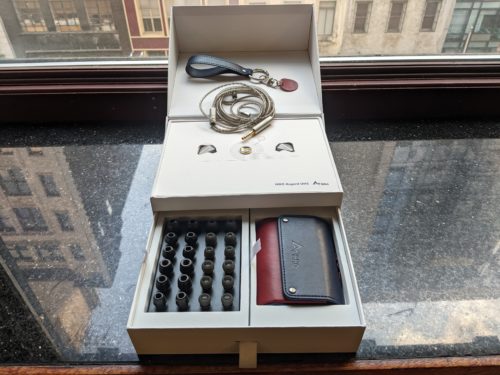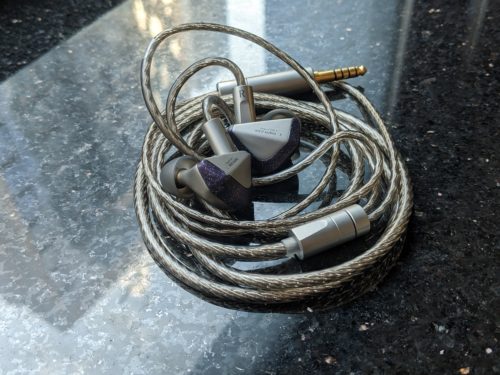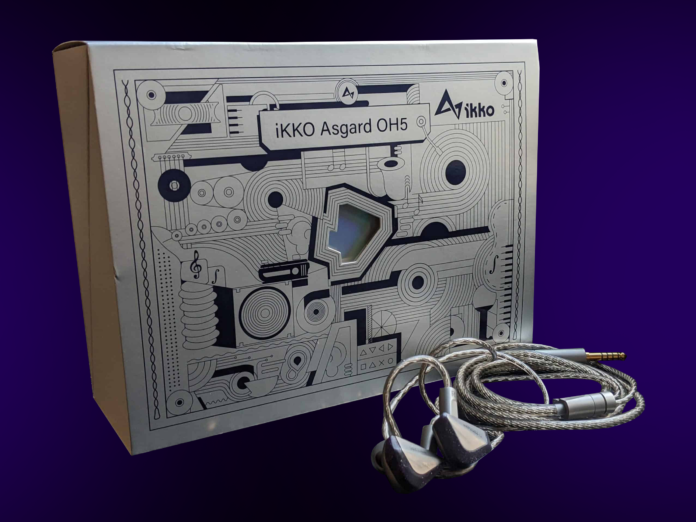iKKO Asgard OH5 IEM Review
I’ll be honest: I have never heard of iKKO until being handed the iKKO Asgard OH5. Established in China a mere 3 years ago, the company features an understandably limited selection of IEMs/earbuds on their site. Hm… My interest was piqued, but when I put these $489 IEMs in my ears, well, my mind was blown. So, get ready for a detailed explanation of why the iKKO Asgard OH5 was an absolute privilege to have in my ears, and why I’ll be paying more attention to iKKO in the future.

What’s In the Box?
-iKKO Asgard OH5 IEM’s
-Detachable 2 pin to 4.4mm Balanced Cable.
–12 Pairs of Eartips:
-3 pairs Circular Foam
-3 Pairs Ovular Foam
-3 Pairs Circular Silicone
-3 pairs Ovular Silicone
-4 pin to 3.5mm adapter
-4 pin to 2.5mm adapter
-Semi Firm Leather Carrying Case
-Key chain
-Button Cuff (?)
Look and Feel
As some one who fancies themselves too hardened in audio to care about packaging, well, the Asgard OH5’s packaging nonetheless left quite an impression for me. Not only is the box sleeve strikingly cool and modern, but the box itself is something of a mini cabinet that’s worth holding onto. The buds sit in a top compartment in a high quality cardboard and foam cut-out that seems ideal for safe storage, while a shelf containing the rest of the accessories slides out from below. The red and blue, semi-firm leathery carrying case isn’t pants-pocket-sized, but can easily fit into the small pocket of a backpack and seems to provide ample protection for the earbuds. The eartip selection was generous and cleanly presented, and I imagine most listeners won’t have much trouble finding their ideal size, shape, and material.
The buds themselves have a particularly pointy and triangular shape to them that reminded me of the angles present on sports cars. They also had some gemstone-like details that reminded me of textures seen on IEMs from ThieAudio. Though I was a bit skeptical how these sharp little guys would fit in my ears, I was relieved to find that all the point present on them was contained to the look, and avoided stabbing the inside of my ears. A little two-handed earlobe tug maneuver was needed get a good and proper fit, but ultimately I couldn’t really complain once they were in. Well, my only minor complaint is about the cable, which I found to have particularly curly memory on the ends that connect to the earbuds, and was also bit too short. That being said, it featured thick plastic insulation on top of silver plated copper wire, and seemed like it wouldn’t take much special care to have last a very long time.
Technical Specifications
The iKKO Asgard OH5 features the world’s first lithium magnesium driver. It wasn’t long ago that the consumer audio community was introduced to cutting beryllium magnesium drivers, frequently featured in high end IEMs and headphones such as Empire Ears ODIN of Focal’s Utopia. Beryllium has favorable qualities for headphone drivers as it is the most rigid metal with an exceptionally low density.
Driver material considerations involve a careful balance of both rigidity and density, thus making the choice of lithium in the Asgard OH5’s driver particularly interesting. While lithium is the lightest of all metals, it isn’t quite as rigid as Beryllium. There are also differences in their magnetic qualities, with beryllium being diamagnetic (repels magnetic fields) and lithium paramagnetic (attracts magnetic fields). I speculate that the high level of insulation around the cable wiring serves to offset potential interference risks posed by having lithium present in the Asgard OH5’s audio signal, which may be helpful to keep in mind (if I’m actually right about that) if you ever plan on changing out the cable. Though I would love to give a technical rundown on the acoustic properties of both beryllium and lithium, it would be rather one sided, as there simply is not much accessible info on lithium acoustics yet.
Driver: Lithium-Magnesium Dynamic
Frequency Response: 20 Hz – 40 kHz
Impedance: 32 ohms
Sensitivity: 112 dB

Sound Stage
The left-right imaging present in the Asgard OH5 was exceptionally fluid and high-def, producing pans that naturally slid from one ear, across every millimeter of my face, to my other ear. The bizarre, extra-spatial mix on the track “Norfolk Hotel” by Melody’s Echo Chamber literally gave me goosebumps when listening with the Asgard OH5 as it hollowed out the inside of my head and filled it with sound. “Be Sweet” by Japanese Breakfast has vocal harmonies and synth tracks that had a way of presenting themselves not just from the left or right, but distinctly shooting either into my ears or past my ears from the side. The level of care that the Asgard puts into spatial placement is euphoric when paired with its obscenely clean balance – I’ll get into that in a moment.
While I didn’t get a particularly grand sense of depth from the Asgard OH5, it was lightly present even if a bit shallow. Most of the 3D qualities felt like they occurred inside my head rather than around it. I have to say that in my experience, only a very select handful of IEMs have given me a cloud-of-sound impression, and probably by no coincidence cost several thousands of dollars. Considering the OH5’s price, this isn’t something worth holding against it. Its staging, imaging and layering were as entertaining as they were engaging and balanced.
Lows
Natural and honest is the name of the game with the Asgard OH5. While some people may read that and think of headphones that merely lazily attenuate low end to avoid masking, this isn’t the case with these iKKO IEMs. Heavy acoustic kick drums like the one featured in the Animal Collective track “Prester John” had a striking realism, packing in a hefty sub bass that never came close to infringing upon the perfectly-present higher transients of the pedal and drum skin. The synth bass in “Human Om” by Tobacco was dissected in way I haven’t quite heard before, with the heavy low end sine wave characteristics powerfully coexisting with, yet clearly distinct from, the buzzy high end of its sawtooth characteristics. Like most of its balance, the Asgard OH5’s low end seems to fall into a Goldilocks area that I imagine would leave vast majority of listeners deeply satisfied.
Mids
The Asgard OH5 could run with any genre that I put it through. Fleet Foxes tracks, which feature a sensitive density mid heavy frequencies due to the heavy presence of vocals and acoustic guitar, came through as balanced and distinctly layered as I was expecting at this point. A really beautiful part about the Asgard OH5 is how it handles vocals by perfectly balancing fundamentals, fry, and air in distinct yet synergistic layers. For those familiar with microphones, the mids profile reminded me of the timbre of an AKG C414 condenser mic. Acoustic instruments and acoustic drums specifically seriously benefited from this precise and clean mids balance. Toms with heavy mid-low decays could ring freely without muddying the mix, while snare drums had the same ratio of thump to pff as they would if they were played right in front of your face.
Highs
Here, we get to the part of the balance that sets this unit from iKKO apart from nearly every IEM I’ve tried, regardless of price point. High frequencies came through with an amazing clarity that made it seem like the Asgard could handle them in its sleep. This might be the first time I could honestly call the high end of a headphone/IEM smooth. I mean really, fine, silky smooth. As some one who likes a lot of highs in a sound signature, I frequently have to pretend like such headphones aren’t making my ears bleed just a little bit. No such pretending was necessary with the Asgard OH5, which could produce highs that were sooner imperceptible than they were harsh. Maybe you’re familiar with my go-to highs test, “Cranked” by Panda Bear, and that needling high frequency that I bring up in nearly every review that I’ve been writing recently. Guess what? There are frequencies in that track that are even higher than the one I’m always talking about, that I never noticed until giving a listen with the OH5. The virtually perfect representation of high end gives an exceedingly tasteful and crisp realism to hi-hats, cymbals, vocal air, harmonics, and an endless variety of transients. This is something I would expect from expensive planar drivers – how iKKO attained this sonic quality in an only somewhat expensive dynamic driver is simply beyond me.
Overall
The iKKO Asgard OH5 is quite simply the epitome of more-than-fairly priced audiophile sound quality. The energetic imaging and squeaky clean yet full balance provides a level of transparency that makes listening mouth-watering-ly addictive. Though $489 is certainly a steep tag for many people, I’m happy to see fantastically high quality IEMs take a step down from being a few thousand dollars to just a few hundred. Frankly, I think the Asgard OH5 easily smokes nearly all IEMs at this price range in terms of sound quality. At this point, you don’t need to ask me if I liked the OH5 – the only question is if I’m going to take the plunge and buy it. If you haven’t heard of iKKO yet, start paying attention.
The iKKO Asgard OH5 is available to purchase from Audio46.

Compare the ranking of various headphones, earbuds and in-ear monitors using our tools.
Discuss this, and much more, over on our forum.
---MAJORHIFI may receive commissions from retail offers.















